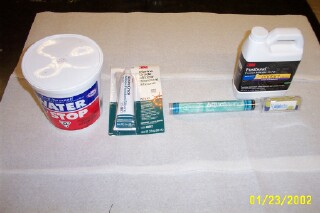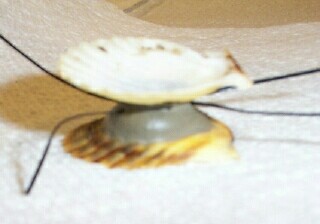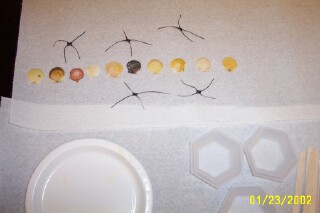|
Sample
preparation task #1, by E. Sichel
 Shown
are hydraulic cement, silicone, Aquamend epoxy, Kneadatite
epoxy, and Fastbond 30-NF contact adhesive. Shown
are hydraulic cement, silicone, Aquamend epoxy, Kneadatite
epoxy, and Fastbond 30-NF contact adhesive.

Shown
are two scallop shells with a piece of netting sandwiched
between them with an adhesive.

Shown
are the shells, the netting pieces, and mixing dishes.
Samples
were prepared in a similar way to the procedure described
in the Martha's Vineyard Shellfish Project report. The pieces
of netting and the scallop shells were soaked in seawater
and then blotted dry with a paper towel. The adhesive was
applied to the shells and the netting was sandwiched between
the shells. The sandwich was left on the bench top for about
15 minutes in air. The sandwich was then immersed in a tray
of seawater, and the covered tray was stored in a refrigerator
at 34 degrees F.
The
adhesive bonds will be inspected in about a week.
Inspection
Report on task #1
Samples
were inspected on January 29, 2002, after 6 days immersed
in seawater at 34 degrees F.
Hydraulic
cement bonds were intact. There was a strong bond to the bottom
shell and a weak bond that could be pulled apart to the top
shell. The cement does not bond to the netting, but a strand
of netting can be held by engulfing it in cement.
Silicone
bonds were intact, but were easily peeled off the shells and
the netting.
Aquamend
bonds were intact. Excellent bond to bottom shell. Top shell,
which was applied with less pressure, could be peeled off.
Kneadatite
bonds were intact. Bonds could be peeled off the shells.
Fastbond
30-NF bonds were intact, but easily peeled off the shells
and off the netting. |

